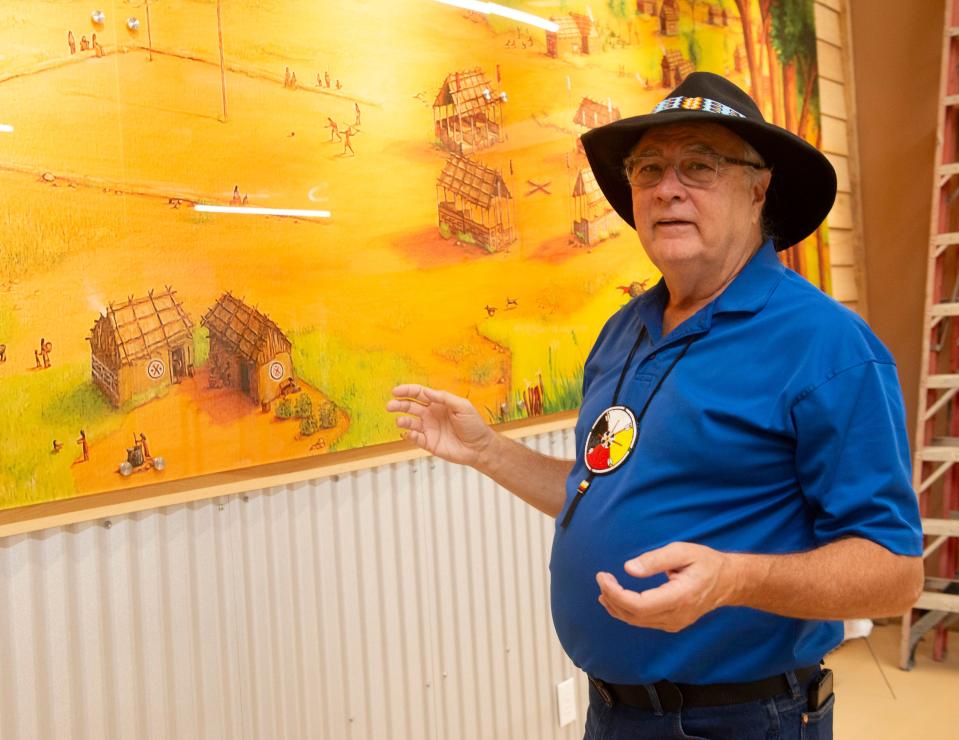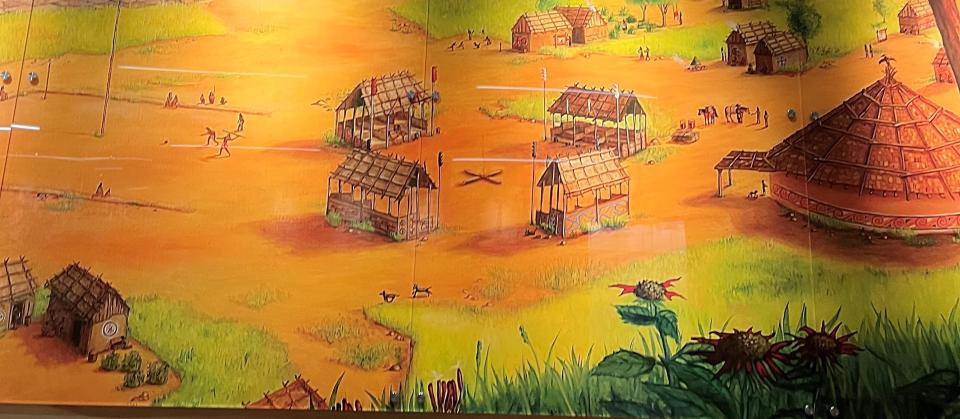Santa Rosa Band of Lower Muscogee makes good on promised educational Cultural Center
Editor's note: This story has been updated to include the correct location of the Cultural Center, which is at 4750 Willard Norris Road in Milton.
For a long time, Dan "Sky Horse" Helms, was forced to carry his vision of showcasing the history and heritage of his people, the Santa Rosa Band of Lower Muscogee Creeks, in his heart and in his mind.
No more. The vision has been made reality inside the Cultural Center at the tribe's property in Milton at 4750 Willard Norris Road.
"This is the culmination of a dream that's been going on a long time," Helms said. "To finally get it out of my head and onto the walls is amazing."
Helms spoke as he stood at the center of a room transformed from what had been and remains a functional community gathering space to an art gallery, museum and technological marvel all wrapped into one.
"It turned out better than I had envisioned," he said. "There's never been anything like this in our area."
Each wall of the 4,000-square-foot building holds eye catching artwork or renderings of some aspect of Native American culture in this area. Hanging from the roof are directional speakers capable of providing a visitor standing beneath them with information about what he or she is looking at while not disturbing others in the room.
Upon entering the building, the visitor comes face to face with portraits of five leaders of the Creek Confederacy. Helms, who had a story about each of the ancient warriors, said that they would have been signers of a treaty with Andrew Jackson that would end the Creek nation as it was in the early 1800s.

Portraits of Native American women hang on each side of the five historic leaders. One features a member of the Euchi tribe that was part of the Creek Confederacy, Helms explained. The young woman was the daughter of a warrior known as "Deer Without a Heart," a moniker given as testament to his brave fighting spirit.
Other walls show Creeks performing ceremonial dances, or provide a glimpse into a day in the life of the local Native Americans.
More: Santa Rosa Tourist Development Council votes to fund Native American Cultural Center
One portion of the wall is dedicated to a tutorial on the language of the Santa Rosa band's people, and another provides a map that shows where the Muscogee tribe's traditional homeland had been, and where the Santa Rosa band had called home.
On another wall stands the one unfinished element of the Cultural Center renovation. A state of the art, museum quality display case that, at the moment, stands empty.
"We're waiting on delivery of artifacts," Helms said.
The Pensacola Museum of History has agreed to loan the tribe artifacts to fill its $24,000 display case.
The artifacts that will occupy the case are part of the collection accumulated by the University of West Florida's Historic Trust, said Robert Overton, the trust's executive director.
The projectiles, arrowheads, bowls, stone tools, stick balls and sticks "will tell part of the story" of the Native American presence in Northwest Florida, Overton said.
He said the Historic Trust is looking forward to playing a role in what historical education the Cultural Center will provide.

For Helms and the band he leads, the Cultural Center dream was hatched about four years ago when tribe members went to the Santa Rosa County Tourist Development Council board looking for financial assistance. After seeing the plans, the board agreed to find funding and approve an allocation at a meeting two weeks down the road.
And then came COVID.
"They never had the meeting, and they didn't meet again for a real long time," Helms said. "When they did start meeting again, they were afraid to spend money."
More: Cultural survival on the run: Pensacola's history shaped by Native Americans
In March of this year, Helms took his case for $70,000 to fund the Cultural Center to the Board of County Commissioners. Commissioners debated funding it, and appeared willing to do so, but decided to instead to see if the TDC would use tourism-generated bed taxes to cover the cost.
The TDC approved the expenditure in April, and Helms said at that time he was holding out hope the Cultural Center could be completed in time for the band's annual Creek Fest, which this year will be held Nov. 18-19.
The tribe not only succeeded in making its self imposed deadline, thanks to "real good shopping and negotiating," it was able to add more amenities at the Cultural Center than originally anticipated, Helms said.
"We spent $70,008.20 cents. I wasn't going to leave anything on the table," Helms said. "And we had to swallow that $8.20."
The Cultural Center's opening will coincide with Creek Fest, an annual festival held on the band's 92 acre grounds for 32 years before COVID. Helms said that ahead of this year's event the group will be providing schools with 7,600 free tickets to the event.
One of the primary functions of the Cultural Center, Helms said, is to educate young people about Native American history and culture, and the new technology incorporated into the building even allows the dialogue directed at students at each learning site to be communicated at a fourth-grade level to the center's target audience.
"I'm so glad to have the opportunity and venue to share our culture and history," Helms said.
This article originally appeared on Pensacola News Journal: Santa Rosa Band of Lower Muscogee ready to open Pace Cultural Center

